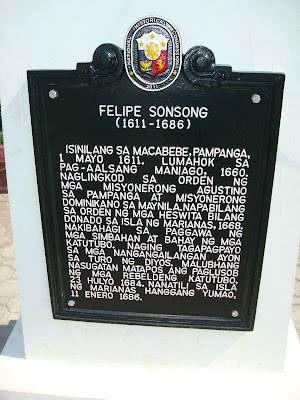 |
grandesp.org.uk
BORJA |
Borja is the name of a town (today, of about 5,000 people) in the province of Zaragoza, region of Aragón, in Spain.
There was also in Spain a humble family named "de Borja" which rose like a meteor to produce no less than popes, cardinals, bishops, political leaders and one saint - in sharp contrast to some of the most scandalous members of that family. Part of the family moved and re-established themselves in Italy where the name is pronounced "Borgia."
The saint, a Jesuit - Saint Francis Borgia, in Spanish "San Francisco de Borja" - was canonized in 1670, just 2 years after the Catholic mission in the Marianas was established. Freshly rejoicing in this honor bestowed upon one of their own members, the church in Songsong, Luta (Rota) was named after him by the Jesuit missionaries and remains so today.
 |
en.wikipedia.org
TOWN HALL IN THE TOWN OF BORJA, SPAIN |
 |
saints.sqpn.com
SAN FRANCISCO DE BORJA
Saint Francis Borgia |
Because of the Jesuit missionaries throughout Latin America and the Philippines, towns named after San Francisco de Borja and churches named in his honor sprung up in many places. "Borja" started to be used as a last name by local people in Latin America and the Philippines.
There are no Borjas listed in either the 1727 or the 1758 Censuses of Guam. So, the Borjas came to the Marianas more recently, probably in the late 1700s or early 1800s. People surnamed Borja from Latin America perhaps, and certainly from the Philippines, moved to Guam during that time.
We know, for example, that one branch of Borjas on Guam (not connected in origin with other Borjas on Guam) came from the city of Zamboanga in Mindanao (Philippines) and their "better-known-as" is Zamboangueño (meaning, someone from Zamboanga). The founder of this clan was Vicente Bazan de Borja, who married a Chamorro named Maria Cruz Guzman.
One of the oldest Borja males listed in the 1897 Census is Catalino Borja (whose middle name, from other documents, was Mendiola). Catalino was 68 years old in 1897 (although many ages in the Census are based on faulty human memory), so he was conceivably born on Guam in 1829.
One Borja married a woman with a truly indigenous surname, Tanoña, and this branch of Borjas are better-known-as the Manaitai clan.
One branch of the Borjas moved to Saipan. Manuel Mendiola Borja, son of Jose Borja and Gabriela Mendiola, married Ignacia Sablan Diaz, daughter of Ramon Diaz and Rita Sablan. This couple moved to Saipan and raised their family. The clan is known as the Tuhu family.
The Borja name is prominent in Sumay/Santa Rita. That branch was founded by Gregorio Guerrero Borja, who married Alejandra Taitano. This large clan in Santa Rita is known as the Ånda family (from Alejandra).
Antonio Borja Won Pat (first Guam delegate and later representative to the U.S. Congress; Speaker of the Guam Legislature for many terms) was part of the Ånda clan on his mother's side. Former Santa Rita Mayor Gregorio Muñoz Borja is another Ånda Borja. Up in Saipan, a well-known politician, now deceased, was Olimpio Borja.
BORJA AS A FIRST NAME
There are a mere 9,000 people in the entire country of Spain that have Borja for their last name. The prominence of Borja as a last name in the Philippines and Latin America (and through them to the Marianas) is due to the missionary promotion of the devotion to San Francisco de Borja. Many indigenous people had to take on last names (most non-Western peoples traditionally do not have a system of using surnames). Some of them adopted religious names (de la Cruz (of the Cross), de los Reyes (of the Kings, as in Three Kings), de los Santos (of the saints), del Rosario (of the Rosary) and so on). Some either adopted or were given "de Borja" as a surname in honor of the saint.
But, recently, far more Spaniards have taken "Borja" as a first name, again in honor of the saint. Thus, in Spain, where just 9,000 people are surnamed Borja, there are 29,000 men with the first name Borja.
In Spain, there are 2 soccer stars and one race car driver with the first name Borja.
 |
alejandro94taker.deviantart.com
BORJA PÉREZ
is such a popular Spanish soccer player they even designed a poster of him running for President, which Spain doesn't have (they have Prime Ministers) |















































